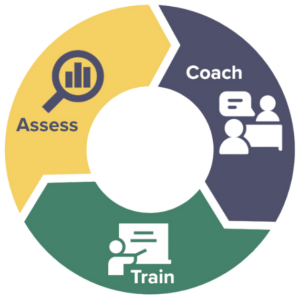The global pandemic shifted what work looks like and where we do it. When remote work is an option available to all employees, everyone benefits, especially people with disabilities.
Every October, the U.S. commemorates Disability Employment Awareness Month. This month “celebrates the contributions of America’s workers with disabilities past and present and showcases supportive, inclusive employment policies and practices.” Remote work allows disabled employees to flourish in the workplace, specifically in relation to disability disclosure, access to care and accommodations, and increased productivity.
Disabled workers aren’t the only ones who tend to prefer remote work. Following six months of working remotely full-time during the early days of the COVID-19 pandemic, 50% of workers stated that they didn’t intend to return to work without remote options. Disabled workers, though, are 14% more likely to leave a job when remote options are rescinded than nondisabled workers are.
As remote work becomes normative among all workers, here are three ways working from home allows disabled employees to be more integrated into the workplace:
Disability Disclosure

If remote work is not a ready option, disabled employees like me must request that accommodation through the Americans with Disabilities Act (ADA) when necessary. As such, we must share basic information pertaining to our disabilities. Otherwise, we often do without support for our needs and bear the stress of hiding our identity. This emotional toll of concealing disabilities and other identities decreases employees’ wellness and productivity.
According to a recent survey by Accenture, “employees with disabilities fear that disclosing will lead to outcomes such as retaliation, slower progression, and less meaningful roles.” Even in the best circumstances, disability disclosure can be complicated emotionally. Conversely, employees are given a greater sense of agency when they are allowed to disclose their disability status when and if they choose.
Alex in Portland, Oregon, wasn’t disabled when she began working remotely in 2020. However, her medical issues and the complex process of being diagnosed with her condition would have prevented her from working in person. She was able to keep her job, and today, because she has difficulty commuting and sitting upright, she continues to work remotely.
Meanwhile, Shanna from Olathe, Kansas, who relies on reading lips, had to disclose her hearing loss more often when masks became required. Working remotely now for reasons unrelated to disability, her “stress has gone way down,” she says.
Because of the accommodations inherent in remote work – minimal travel time, ability to use preferred and varied seating, availability of food preparation in an allergen-free environment, and breaks for bathroom use without drawing attention to themselves – many disabled workers don’t have to ask for the accommodations they might require otherwise. As it is, only one in four disabled employees disclose their needs to Human Resources or their direct supervisor, decreasing to one in five at the C-suite level.
At the same time, you shouldn’t assume that all employees with disabilities prefer remote work. Ideally, a remote schedule is a choice, with the employee having the agency to consider which available options are best for them and the freedom to adjust their choices as circumstances require.
Access to Care and Accommodations

Becky, in Madison, Wisconsin, isn’t disabled herself, but her children have varying levels of disability. “They are healthier than they’re ever been because of the flexibility my remote work role offers me,” she says.
Mary Ellen, in Sacramento, California, is caring for her partner after a major surgery and enjoys the flexibility inherent in working from home. Instead of having to take unpaid time off, she’s able to continue in her job with minimal leave while picking up prescriptions and providing other caregiving tasks.
Akilah, in Bradenton, Florida, is better able to care for themself while working at home, because their medical condition requires them to lie flat for part of each working day. They’ve arranged a slanted desk that can adjust over their body so they can rest while working, something that would be impossible in most work spaces.
“I wouldn’t be able to work if I couldn’t do it from my bed,” says Akilah, who has myalgic encephalomyelitis/chronic fatigue syndrome (ME/CFS).
Increased Productivity

In research for the book Remote, Inc., authors Alexandra Samuel and Robert Pozen found that more than half of remote employees reported increased productivity while working out of the office than in person.
Casey, in Perkasie, Pennsylvania, found that to be true. She says working at home allows her to remain in an environment with a controlled temperature, familiar muted sounds, low lighting, and a variety of places to sit or stand. “The flexibility with hours makes it possible to be a better employee,” she says.
Jason, in Greensboro, North Carolina, finds that working from home allows him to avoid calling in sick. “When my blood sugar drops or is high, I can still clock in to work, whereas if I had to commute to work, my driving would be limited based on blood sugar levels causing late arrival or absences,” he says. “Also, as someone with autism, face-to-face communication is exhausting for me. Being able to type messages to my leaders rather than sit face-to-face is helpful.”
When remote work is allowed for all workers, regardless of disability, the workplace becomes more diverse, equitable, and inclusive. When allowed, a significant majority of Black workers prefer hybrid or remote work situations, for example. No current research breaks this out into preferences among disabled Black people, because more studies are needed to fully explore the intersection of disability and other identity areas.
Ultimately, remote work as an option to all workers allows organizations to include disabled workers, which benefits companies and workers with disabilities. As you hire or manage the work of people like Alex, Shanna, Casey, Akilah, and Jason, you won’t know the exact ways in which working remotely accommodates their disabilities or simply their preferences, but the Alexes, Shannas, Caseys, Akilahs, and Jasons of your workplace know.
As we wrap up National Disability Employment Awareness Month, consider how remote work can change your business practices to fit the needs of disabled workers instead of requiring disabled workers to adapt to an inflexible environment.
For other guidance in fully including employees with disabilities, watch Leveling Up Your Workforce Through Disability Inclusion, a webinar to help you navigate other issues related to disability and work.
Shannon Dingle is a writer, speaker, and inclusion consultant in Raleigh, North Carolina. She cares deeply about the full belonging of disabled people in all aspects of life. Her memoir Living Brave is a personal account of resilience and hope, and she is working on a primer on disability and ableism as her second book.














